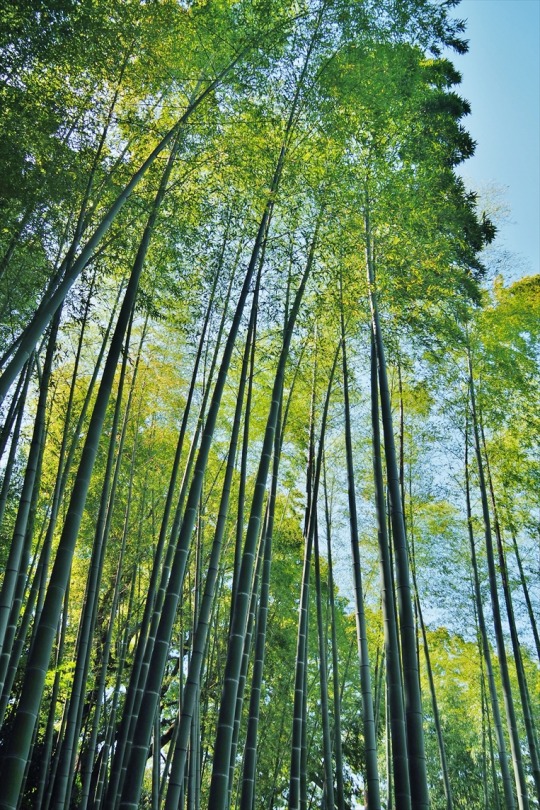#Imperial Palace East Gardens
Explore tagged Tumblr posts
Text
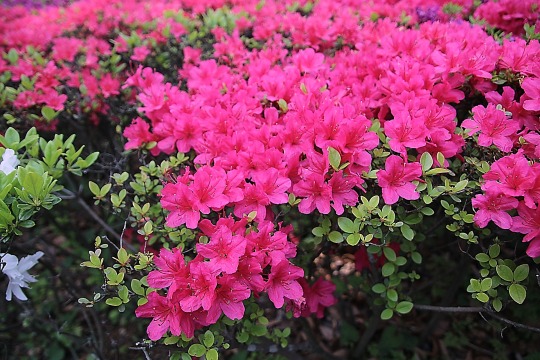
To Plant a Garden is to Believe in Tomorrow.
– Audrey Hepburn
#Azaleas#Pink#Flowers#Rhododendron#Shrub#Japanese Azalea#Imperial Family#Garden#Flower Bed#Petals#Spring#Tokyo Imperial Palace#Ninomaru Garden#Imperial Palace East Gardens#Tokyo#Japan
20 notes
·
View notes
Text

春を迎える竹林
2012年、皇居東御苑。
竹林前の河津桜が咲いて春らしい光景。
#Lightroom Classic#VSCOfilm#photographers on tumblr#lensblr#original photographer#original photographers#original photographers on tumblr#original photography#original photography blog#original photography on tumblr#photoblog#photography#spring#spring season#spring season in Japan#spring season mood#spring season time#spring season tint#March#Japan#Tokyo#弥生#日本#東京#皇居東御苑#河津桜#The East Gardens of the Imperial Palace#Kawazu Zakura
215 notes
·
View notes
Text

Regal Reverie: Imperial Tokyo Palace!
#Imperial Tokyo Palace#Japan#history#culture#architecture#royalty#gardens#traditional#elegance#heritage#landmarks#emperor#empress#Tokyo#East Asia#tourism#sightseeing#travel#Asian architecture#symbolic#regal#opulence#magnificent#serene#majestic#historic site#cherry blossoms#scenic#breathtaking#iconic
7 notes
·
View notes
Text
Tokyo tour, Imperial palace east garden, Robot cafe’Dawn cafe’, Hachiko faithful dog, Shibuya crossing, Sensoji temple Asakusa, Tokyo Skytree !!
Tokyo tour, Imperial palace east garden, Robot cafe’Dawn cafe’, Hachiko faithful dog, Shibuya crossing, Sensoji temple Asakusa, Tokyo Skytree !! Hi I’m Nobu, I like traveling overseas and in Japan every year , visited 26 countries! I’m a National Government Licensed Guide Interpreter of English for 10 years. For the people who are interested in and planning trip to Japan ,I show you hidden…
#Asakusa#Dawn cafe#Hachiko#imperial palace east garden#Sensoji temple#Shibuya crossing#Tokyo#Tokyo Skytree#Tokyo travel tips
1 note
·
View note
Text
in addition to being prone to an obvious naturalistic fallacy, the oft-repeated claim that various supplements / herbs / botanicals are being somehow suppressed by pharmaceutical interests seeking to protect their own profits ('they would rather sell you a pill') belies a clear misunderstanding of the relationship between 'industrial' pharmacology and plant matter. bioprospecting, the search for plants and molecular components of plants that can be developed into commercial products, has been one of the economic motivations and rationalisations for european colonialism and imperialism since the so-called 'age of exploration'. state-funded bioprospectors specifically sought 'exotic' plants that could be imported to europe and sold as food or materia medica—often both, as in the cases of coffee or chocolate—or, even better, cultivated in 'economic' botanical gardens attached to universities, medical schools, or royal palaces and scientific institutions.
this fundamental attitude toward the knowledge systems and medical practices of colonised people—the position, characterising eg much 'ethnobotany', that such knowledge is a resource for imperialist powers and pharmaceutical manufacturers to mine and profit from—is not some kind of bygone historical relic. for example, since the 1880s companies including pfizer, bristol-myers squibb, and unilever have sought to create pharmaceuticals from african medicinal plants, such as strophanthus, cryptolepis, and grains of paradise. in india, state-created databases of valuable 'traditional' medicines have appeared partly in response to a revival of bioprospecting since the 1980s, in an increasingly bureaucratised form characterised by profit-sharing agreements between scientists and local communities that has nonetheless been referred to as "biocapitalism". a 1990 paper published in the proceedings of the novartis foundation symposium (then the ciba foundation symposium) spelled out this form of epistemic colonialism quite bluntly:
Ethnobotany, ethnomedicine, folk medicine and traditional medicine can provide information that is useful as a 'pre-screen' to select plants for experimental pharmacological studies.
there is no inherent oppositional relationship between pharmaceutical industry and 'natural' or plant-based cures. there are of course plenty of examples of bioprospecting that failed to translate into consumer markets: ginseng, introduced to europe in the 17th century through the mercantile system and the east india company, found only limited success in european pharmacology. and there are cases in which knowledge with potential market value has actually been suppressed for other reasons: the peacock flower, used as an abortifacient in the west indies, was 'discovered' by colonial bioprospectors in the 18th century; the plant itself moved easily to europe, but knowledge of its use in reproductive medicine became the subject of a "culturally cultivated ignorance," resulting from a combination of funding priorities, national policies, colonial trade patterns, gender politics, and the functioning of scientific institutions. this form of knowledge suppression was never the result of a conflict wherein bioprospectors or pharmacists viewed the peacock flower as a threat to their own profits; on the contrary, they essentially sacrificed potential financial benefits as a result of the political and social factors that made abortifacient knowledge 'unknowable' in certain state and commercial contexts.
exploitation of plant matter in pharmacology is not a frictionless or infallible process. but the sort of conspiratorial thinking that attempts to position plant therapeutics and 'big pharma' as oppositional or competitive forces is an ahistorical and opportunistic example of appealing to nominally anti-capitalist rhetoric without any deeper understanding of the actual mechanisms of capitalism and colonialism at play. this is of course true whether or not the person making such claims has any personal financial stake in them, though it is of course also true that, often, they do hold such stakes.
541 notes
·
View notes
Text









Vitola Palace, the official residence of the Simsicilian monarch.
Here is an outside guide of the Palace.
-Vitola Palace Front side: Also known as the Front-Wing houses all of the state rooms. At the center of this wing we also have the famous balcony of the palace.
-Palace Gate: The gate is located west of the palace where you directly enter the west gardens.
-The West-Wing: This wing houses the apartments of the monarch, filled with lavish luxury rooms. This is as private as it gets for the Imperial family.
-Palacio de la Mare: Is a palace directly across from the west-wing. Emperor Augusto built this palace for his mother, Queen Anne of Valegona. Every Empress Mother has resided in this palace ever since.
-The East-Wing: There isn't a picture shown but the outside is a direct copy of the west-wing. The inside however houses multiple apartments for other lower ranking members of the Imperial family.
-St Augusto Cathedral: Formerly known as St Maria Antonia's Cathedral was remodeled after the accession of Emperor Augusto.
-Flags: The flag of Simsicily always flies above the front-wing, but the standart flag of the monarch only flies on the west-wing front tower when the monarch is at the palace.
We hope you enjoyed our virtual tour!
#royal sims 4#sims royal family#simblr#sims story#sims royal legacy#the sims 4#the sims community#ts4 royalty#sims 4#sims 4 screenshots#sims screenshots#the sims#sims 4 gameplay#my sims#sims community#ts4 royal simblr#ts4 simblr#sims royaltstory#sims royalty#ts4 royal family#ts4 royal legacy#ts4 royal story#sims build#ts4 build
81 notes
·
View notes
Text
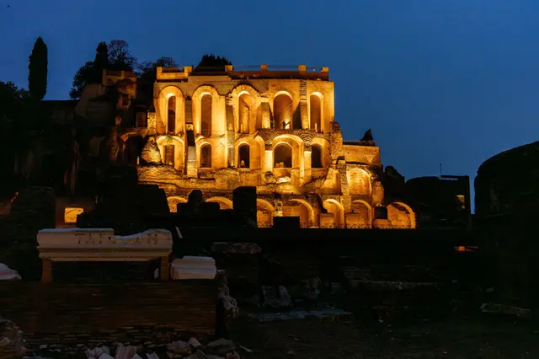
Rome’s 'Lost' Imperial Palace 'Domus Tiberiana' Reopens
Until recently a crumbling and off-limits ruin near the famous Colosseum, the Domus Tiberiana palace — built in the first century AD and beloved by Nero — hopes to once again take its place as one of the city’s top tourist attractions.
The ancient palace sits on Palatine Hill — the city’s oldest hill, overhanging Rome —from where imperial dynasties ruled for centuries. But over the years, the site fell into disrepair and in the 1970s, the Domus Tiberiana site was shut due to the structural instability of some of the ruins. The closure left behind what many Romans described as a “black hole” in the capital’s archaeological heart.
Now, after a six-year makeover, the palace has reopened its doors as a “diffuse museum,” with findings and frescoes scattered across the site to provide visitors with an insight into the palace’s ancient grandeur.
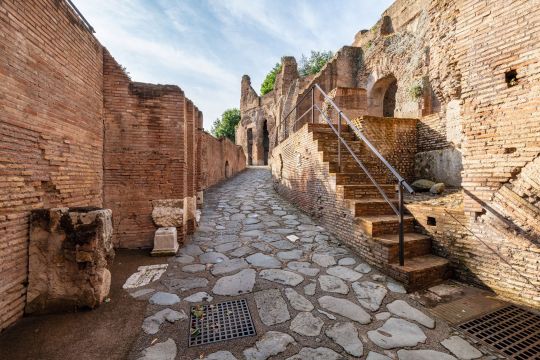
And it was grand. The Domus Tiberiana was Rome’s first imperial palace, built by the emperor Tiberius who combined and incorporated the pre-existing noble mansions built on the hill. Occupying over four hectares, the palace featured residences alongside large gardens, places of worship and rooms for the emperor’s Praetorian guard.
As the seat of Rome’s power and politics, Domus Tiberiana held a prime location, high above the Palatine and Roman Forums, offering its occupants a “balcony view of the city.” Over time, the Domus was embellished and enlarged by other emperors including Nero, who was crowned on its steps aged just 16, in 54 AD.
Alfonsina Russo, director of the Colosseum’s archaeological park (in which Domus Tiberiana falls) and lead archaeologist on the renovation, said that ancient antiquities, many exceptionally well-preserved, were unearthed during the project.
The artifacts — bright stuccos, frescoes, amphorae, potteries, looms, terracotta, and divinity statues related to the cults of Isis, Dionysius and Mithras — offer visitors a trip through time, said Russo.
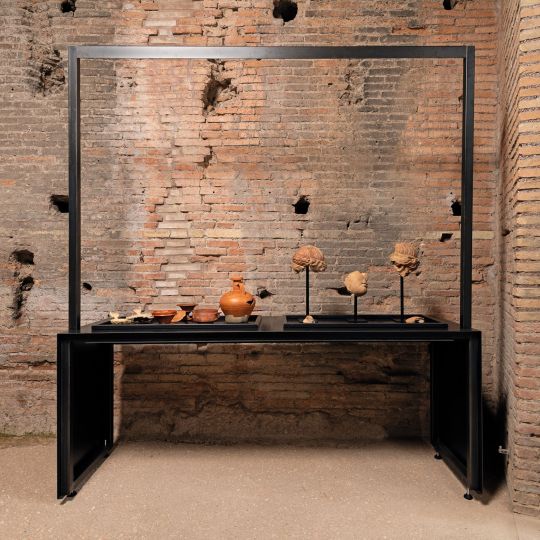
“They make this place — formerly (inhabited) by aristocratic families, then Roman emperors — feel alive again,” she said. “There are seven exhibition rooms full of extraordinary finds, starting with those preceding the original construction of the palace when aristocrats lived in mansions before Tiberius subsumed them into the Domus.”
Among the newly-exposed and frescoes are some of the earliest paintings of lemons (considered an exotic fruit in Ancient Rome, as they hailed from the Far East) and a depiction of a gladiator, proving that the era’s gladiatoral games were appreciated by rich families, explained Russo.
The imperial palace remained in use until the 7th century, when it became the papal residence of John VII. In the mid-16th century, the aristocratic Farnese family — who were powerful local landowners — built the lavish Orti Farnesiani gardens on the site, adorning it with ornaments and sculptures of nymphs, satyrs and fauns.
“This monument speaks of history,” Russo added. “We have restored (Domus Tiberiana) to its past splendor, but more work lies ahead.”
Indeed, painstaking efforts have been made to blend old and new. A series of majestic, reddish-brown vaulted arches that greet visitors having been carefully reconstructed with the same materials as ancient Romans used in the past.
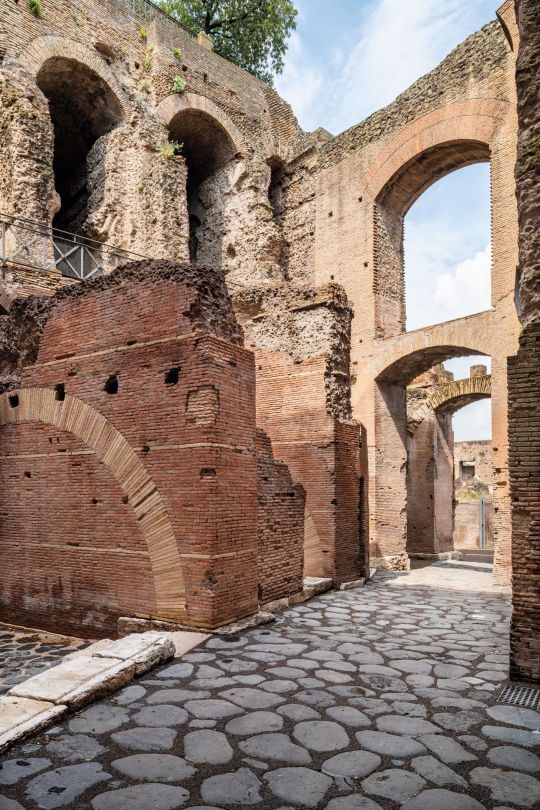

“What makes this revamped Domus unique is the architectural style,” said Russo. “We managed to use original materials to reinforce and strengthen the handmade 15-meter (50ft) tall front arches (which run alongside the palace’s) ancient paving.”
It has certainly caught the public’s attention. Since reopening at the end of September, Domus Tiberiana has attracted some 400,000 visitors, a “huge success,” said Russo, adding that she believes that this incarnation of the Domus Tiberiana offers visitors the most “evocative” visit in generations.
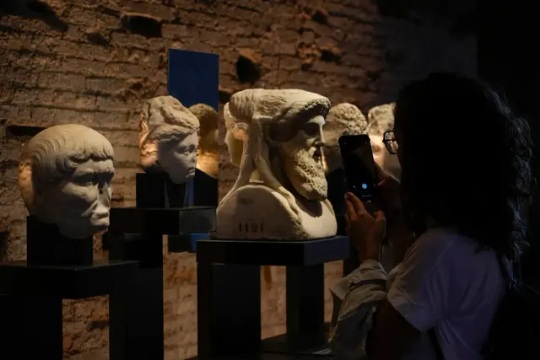
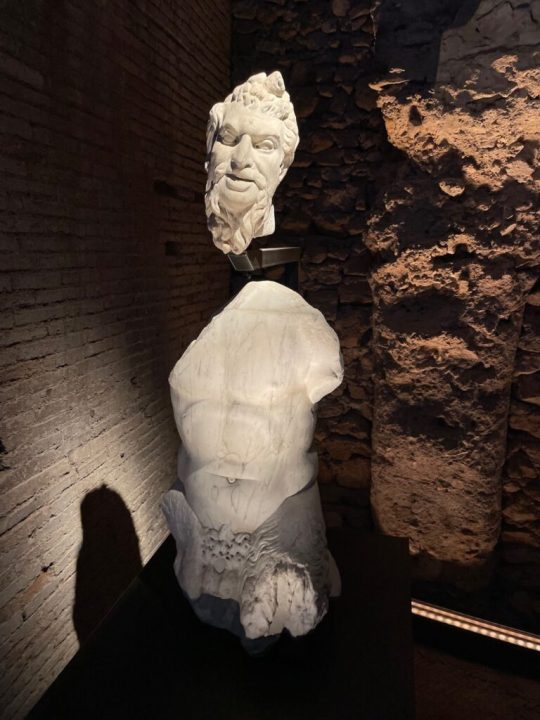
Archaeologist and scholar of ancient Rome Giorgio Franchetti saidN that, in the reopening of the Domus Tiberiana complex, Rome has “recovered a lost jewel.”
“The Palatine Hill has always been the stage of Rome’s power politics,” he said in an interview. “Tiberius likely chose this spot to build the palace as it was where his family residence stood. There aren’t many places like the Domus Tiberiana where you can really breathe the past.”
By Silvia Marchetti.
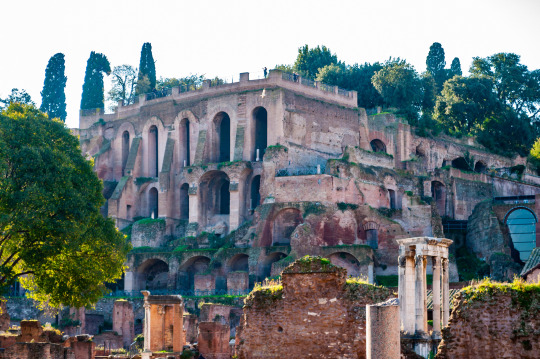
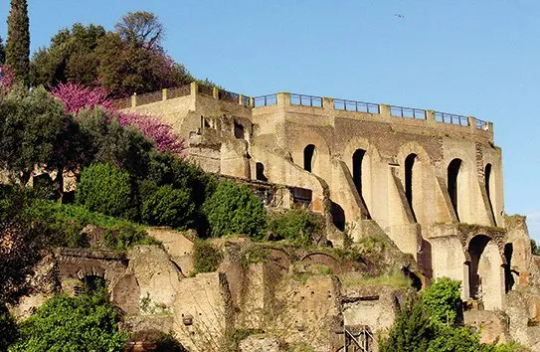

#Rome’s 'Lost' Imperial Palace 'Domus Tiberiana' Reopens#Domus Tiberiana palace#Palatine Hill#Emperor Tiberius#Emperor Nero#ancient artifacts#archeology#archeolgst#history#history news#ancient history#ancient culture#ancient civilizations#ancient rome#roman history#roman empire#roman emperor#roman art
274 notes
·
View notes
Text

The Otamon (or Ota Gate) at the East Gardens of the Imperial Palace
20 notes
·
View notes
Text
A walk through Bengal's architecture
Bengali architecture has a long and rich history, fusing indigenous elements from the Indian subcontinent with influences from other areas of the world. Present-day Bengal architecture includes the nation of Bangladesh as well as the Indian states of West Bengal, Tripura, and Assam's Barak Valley. West Bengal’s architecture is an amalgamation of ancient urban architecture, religious architecture, rural vernacular architecture, colonial townhouses and country houses, and modern urban styles. Bengal architecture is the architecture of Wind, Water, and Clay. The Pala Empire (750–1120), which was founded in Bengal and was the final Buddhist imperial force on the Indian subcontinent, saw the apex of ancient Bengali architecture. The majority of donations went to Buddhist stupas, temples, and viharas. Southeast Asian and Tibetan architecture was influenced by Pala architecture. The Grand Vihara of Somapura, which is now a UNESCO World Heritage Site, was the most well-known structure erected by the Pala rulers.

The Grand Vihara of Somapura
According to historians, the builders of Angkor Wat in Cambodia may have taken inspiration from Somapura. Bengal architecture became known for its use of terracotta due to the scarcity of stone in the area. Clay from the Bengal Delta was used to make bricks.
The temple architecture has distinct features like the rich wall decoration, often known as the terracotta temples, which was one of the remarkable elements of Bengali temple architecture. The double-roofed architecture of thatched huts was replicated by Bengali temples. Square platforms were used to construct the temples. Burnt brick panels with figures in geometric patterns or substantial sculptural compositions served as the temples' adornment.

Dochala style
These served as models for many temples that were built in undivided Bengal. Construction materials used in ancient times included wood and bamboo. Bengal has alluvial soil, so there isn't a lot of stone there. The bricks that were utilized to build the architectural components were made from stone, wood, black salt, and granite. Bengal has two different types of temples: the Rekha type, which is smooth or ridged curvilinear, and the Bhadra form, which has horizontal tiers that gradually get smaller and is made up of the amalaka sila. Mughal architecture, including forts, havelis, gardens, caravanserais, hammams, and fountains, spread throughout the area during the Mughal era in Bengal. Mosques built by the Mughals in Bengal also took on a distinctive regional look. The two major centers of Mughal architecture were Dhaka and Murshidabad. The do-chala roof custom from North India was imitated by the Mughals.

Jorasako thakurbari
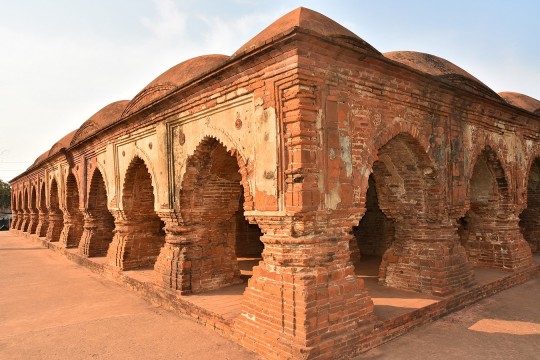
The Rasmancha is a heritage building located at Bishnupur, Bankura district, West Bengal.
Influence of the world on Bengal architecture: Although the Indo-Saracenic architectural style predominated in the area, Neo-Classical buildings from Europe were also present, particularly in or close to trading centers. While the majority of country estates had a stately country house, Calcutta, Dacca, Panam, and Chittagong all had extensive 19th and early 20th-century urban architecture that was equivalent to that of London, Sydney, or other British Empire towns. Calcutta experienced the onset of art deco in the 1930s. Indo-Saracenic architecture can be seen in Ahsan Manzil and Curzon Hall in Dhaka, Chittagong Court Building in Chittagong, and Hazarduari Palace in Murshidabad.
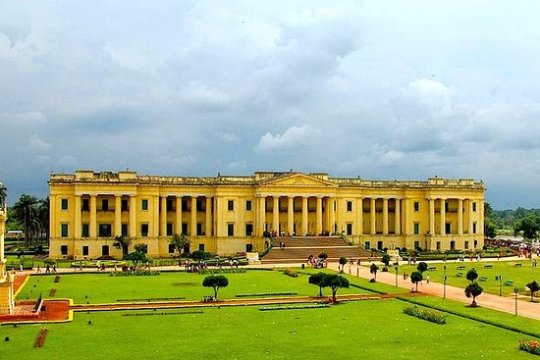
Hazarduari Palace in Murshidabad
The Victoria Memorial in Kolkata, designed by Vincent Esch also has Indo-Saracenic features, possibly inspired by the Taj Mahal. Additionally, Kolkata's bungalows, which are being demolished to make way for high-rise structures, have elements of art deco. The 1950s in Chittagong saw a continuation of Art Deco influences. The Bengali modernist movement, spearheaded by Muzharul Islam, was centered in East Pakistan. In the 1960s, many well-known international architects, such as Louis Kahn, Richard Neutra, Stanley Tigerman, Paul Rudolph, Robert Boughey, and Konstantinos Doxiadis, worked in the area.

The Jatiyo Sangshad Bhaban
This iconic piece of contemporary Bangladeshi architecture, was created by Louis Kahn. Midsized skyscrapers dominate the cityscapes of contemporary Bengali cities, which are frequently referred to as "concrete jungles." With well-known architects like Rafiq Azam, architecture services play a key role in the urban economies of the area. Overall Bengal architecture was influenced by various contemporaries of their time and continues to evolve.

Gothic architectural style seen in St. Paul's Cathedral in Kolkata.

Zamindar era buildings in ruin.

Belur Math in Howrah
#bengali#bangla#west bengal#bangladesh#tripura#assam#desi#বাংলা#india#architecture#tales#bengal architecture#history#kolkata#international#technology#information#temple#asia#bricks
193 notes
·
View notes
Text
The Imperial Family's Gardens🏡










#Imperial Palace East Gardens#Tokyo Imperial Palace#Ninomaru Garden#Imperial Family#Garden#Kimono#Lake#Pond#Carp#Fish#Taisho Sanshoku#Flowers#Bamboo#Japanese Garden#Chiyoda#Tokyo#Japan
29 notes
·
View notes
Text

Reflections of Edo in Tokyo’s Urban Landscape・皇居の正門石橋と二重橋:歴史と現代が交わる場所
Just before entering the main courtyard, where thousands had gathered in an orderly fashion to hear the annual New Year’s greeting from Japan’s emperor and the imperial family, I crossed the moat via Nijubashi Bridge (二重橋). From here, I had a fantastic vantage point looking east—Seimon-Ishibashi Bridge (正門石橋) reflected on the moat’s still waters, the expansive Kokyo-mae Hiroba (皇居前広場) gardens stretched out in the midground, and the steel-and-glass towers of Tokyo’s Marunouchi financial district rose in the background.
Looking across the plaza and gardens, with its neatly sculpted pine trees and golden winter grass set against the gleaming skyscrapers, I closed my eyes and tried to imagine the scene from this bridge over 400 years ago—when the urbanscape was still a saltwater bay.
Back in 1592, the Hibiya Inlet (日比谷入江) was an estuary that fed into Tokyo Bay. Its proximity to the Pacific Ocean allowed ships to navigate inland, transporting essential materials like lumber and quarried stone for the construction of castle structures, bridges, and fortifications. Over time, the moat before me was excavated, forming part of a vast 12-kilometer (7.5-mile) system that spiraled outward from Edo Castle. These waterways not only served defensive purposes but also enabled the marine transport of building materials and goods from distant regions, fueling Edo’s rapid expansion.
As the moats were dug, the excavated soil was repurposed to reclaim land from the Hibiya Inlet. This newly created land became the site of grand estates and meticulously designed gardens for approximately 300 daimyo feudal lords. Today, those once-private spaces have transformed into public areas—the Kokyo-mae Hiroba garden (皇居前広場), visible in the midground of my photo, and the Marunouchi district, now home to towering business complexes and Tokyo Station, hidden just beyond the skyscrapers.
Full write-up with links to sources for a deeper dive (1-minute read): https://www.pix4japan.com/blog/20250102-nijubashi
Location: Imperial Palace, Chiyoda Ward, Tokyo
Timestamp: 10:29・2025/01/02
Fujifilm X100V with 5% diffusion filter
ISO 320 for 1/500 sec. at ƒ/5.6
Provia/Standard film simulation
22 notes
·
View notes
Text
東京都
Japanese Prefectures: Kantō - Tokyo
都道府県 (とどうふけん) - Prefectures of Japan
Learning the kanji and a little bit about each of Japan’s 47 prefectures!
Kanji・漢字
東 ひがし、トウ east
京 キョウ、ケイ capital; 10**16 (ten quadrillion)
都 みやこ、ト、ツ metropolis, capital
関東 かんとう Kanto, region consisting of Tokyo and surrounding prefectures
The capital of Japan, Tokyo has 23 special wards (東京都区部), 26 cities, 1 district (西多摩郡), and 4 subprefectures (支庁)

Tokyo is the largest urban and industrial agglomeration of Japan. Since ancient times the unassuming fishing village of Edo existed for centuries before the Tokugawa shogunate (1603-1867) made it into the capital city, while the imperial family remained in Kyoto. The Tokugawa shogunate ended with the Meiji Restoration of 1868, and Edo became the official capital of Japan, renamed to Tokyo, meaning "eastern capital." It was already the largest city in Japan and the population exceeded one million. Now it is one of the world's most populous cities and the largest industrial, commercial, and financial center in Japan. The Imperial Palace, the home of the emperor of Japan, lies at the heart of the city, encircled by stone-walled moats and broad gardens. Tokyo is the chief transportation hub for Japan and an important international traffic center, and also Japan's major cultural center.
Recommended Tourist Spot・おすすめ観光スポット Shinjuku Gyoen National Garden - 新宿御苑

Shinjuku Gyoen National Garden
When it comes to Tokyo there is an endless list of things to do and see. So picking one to highlight was difficult, but I went with a favorite of mine. Located a short walk from Shinjuku Station, spacious lawns, meandering walking paths and tranquil scenery of Shinjuku Gyoen provide a relaxing escape from the busy urban center around it. In the spring, Shinjuku Gyoen becomes one of the best places in the city to see cherry blossoms, and in the fall the autumn colors are stunning. With an admission fee of only ¥500, it is a wonderful way to get lost in the beauty of an oasis in the middle of the metropolis.
Shinjuku Gyoen, meaning Shinjuku Imperial Garden, originated during the Edo Period (1603-1868) as a feudal lord's Tokyo residence. Later, it was converted into a botanical garden before being transferred to the Imperial Family in 1903 who used it for recreation and for the entertainment of guests. The park was almost completely destroyed during World War II, but was eventually rebuilt and reopened in 1949 as a public park.
There are three main gardens - the Japanese garden, the French garden, and the English garden - as well as a greenhouse full of tropical flowers. There are restaurants and cafes, a tea room, and a rest house with souvenirs. The garden is so large that I have never been able to view it all in one visit.
Regional Cuisine - 郷土料理 Monjayaki - もんじゃ焼き

Monjayaki (source)
A type of pan-fried batter or savoury pancake, monjayaki is Tokyo’s version of okonomiyaki, the iconic dish of Hiroshima and Osaka. Monjayaki looks less like a potato pancake than okonomiyaki and retains a slightly runny appearance similar to melted cheese, even when cooked, but the cooking method remains the same.
The origins of monjayaki or monja can be traced back to a crêpe-like confection known as mojiyaki in the late Edo period. It was called mojiyaki (moji means character, as in hiragana) because people used it to write characters on the hot griddle surface. Monja experienced a popularity boom in the 1980s that led to the birth of Monja Street on Nishinakadori in Tsukishima where today 75 monja restaurants line the street.
To cook monja, first, stir-fry the ingredients, consisting of meats, veggies, cheese, and mochi or crispy noodles – on the griddle. Once they��re almost cooked, form a doughnut shape with a hole in the middle and pour the batter into it. Wait until the batter starts to boil, then mix it all up and press it down with the spatula to better cook it. Then scoop it into a bowl or onto a plate and enjoy.
Tokyo Dialect・Toukyou no hougen・東京の方言
Generally, the Tokyo dialect is taken to be Standard Japanese, although slang can vary between regions and social classes. Traditional dialects in central Tokyo are generally classified in two groups: Yamanote dialect (山の手言葉, Yamanote kotoba) and Shitamachi dialect (下町言葉, Shitamachi kotoba). The Yamanote dialect is characteristic of the old upper class from the Yamanote area. Since the Meiji period, Standard Japanese has been based on the Yamanote dialect. The Shitamachi dialect is a working-class dialect, and it preserves features of Edo Chōnin (Edokko) speech, also called Edo dialect (江戸言葉, 江戸弁, Edo kotoba, Edo-ben). Tokyo-style rakugo is typically played in the Shitamachi dialect.
Tokyo dialect dates back to Tokugawa Ieyasu's establishment of Edo as the main capital. Large groups of people, speaking a range of dialects migrated across the country from the former capital of Kyoto. The Kyoto dialect was the prestige language of the time and strongly influenced the Edo dialect in the early Edo period. The Edo dialect grew as Edo became the largest city in Japan and became the new prestige language in the late Edo period. Because of its unique history, especially in relation to the Kyoto dialect, Tokyo is what is known as a language island in the Kantō region. For example, traditional Kantō dialects have been characterized by the use of volitional and presumptive suffix -be, which is rarely used in Tokyo.
あたぼー (atabou)
Standard Japanese: 当たり前 (atari mae) English: obviously
あんまり (anmari)
Standard Japanese: あまり (amari) English: not very much
しょっぱい (shoppai)
Standard Japanese: 塩辛い (shiokarai) English: salty
でかい (dekai)
Standard Japanese: 大きい (ookii) English: big
About Tokyo dialect (Japanese page)
#japanese prefectures#日本語#japanese#japanese language#japanese langblr#langblr#studyblr#都道府県#東京都#tokyo
30 notes
·
View notes
Text
Tokyo tour! Imperial Palace East Garden, Odaiba( manmade island), Love sign, Statue of Liberty, Shibuya Crossing, Takeshita street, rainbow cotton candy!
Tokyo car tour! Imperial Palace East Garden, Odaiba( manmade island), Love sign, Statue of Liberty, Shibuya Crossing, Takeshita street, rainbow cotton candy! Hi I’m Nobu, I like traveling overseas and in Japan, visited 26 countries! I’m a National Government Licensed Guide Interpreter of English for 10 years. For the people who are interested in and planning trip to Japan ,I show you hidden…
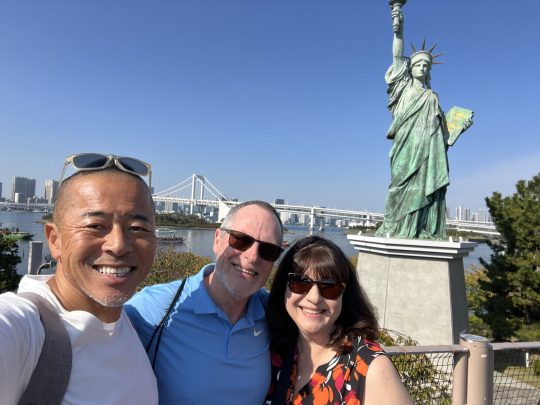
View On WordPress
#imperial palace east garden#Odaiba seaside park#raimbow cotton candy#Shibuya crossing#Statue of Liberty#takeshita street#Tokyo travel tips
1 note
·
View note
Text
Long ago there was a place here called Takashiba Slope. A man from this area was sent to be a fire keeper for the palace’s fire hut. Once, when he was sweeping the imperial garden, he murmured to himself this complaint, ‘Why, oh why, have I met such a cruel fate? On the seven, on the three, sake vats of my home country lie straight handles of gourd ladles. South blows the wind, they drift to the north; North blows the wind, they drift to the south; West blows the wind, they drift to the east; East blows the wind, they drift to the west. None of which I see, just stuck here like this.’ At that moment, the emperors’s daughter (a much treasured person) was standing by herself at the edge of the bamboo blinds. Leaning against a pillar, she gazed out and was much moved by the serving man’s solitary complaint. What kind of gourd ladles were they? How did they drift one way and another? Becoming curious about this, she raised the bamboo blinds and summoned him, ‘You over there, come here.‘ When, full of trepidation, he came over beside the balustrade, she ordered him, ‘That which you just spoke, repeat it one more time for me.’ And so he repeated the words about the sake vats one more time. At this point, she ordered him, ‘Take me there and show me these things; I have a reason for saying so.’ Although he felt terribly afraid, (was this not something fated to happen?), he carried her on his back down to his home country. Now, thinking that surely they would be followed, that night he sat down the princess at the foot of the Seta Bridge and destroyed a whole section of it. Leaping back over it, he hoisted the princess on his back, and seven days and seven nights later, they arrived in the province of Musashi. The emperor and empress were distraught when they realized the princess had disappeared. When they searched for her, someone said, ‘There is a manservant, a fire keeper from the province of Musashi, who flew away with a very fragrant bundle around his neck.’ When they inquired after this manservant, he was gone. Surely he must have returned to his home province, they thought. But when the members of the court’s envoy expedition who were chasing after him found the Seta Bridge broken, they could not continue. Three months later, when they arrived in Musashi and found this manservant, the princess summoned the imperial envoy into her presence and made the following pronouncement: ‘I, for it seems to have been meant to be, became very curious about this man’s home, and when I said, “Take me there,” he brought me here. I find it very pleasant here. If this man is punished for having committed a crime, then what about me? For me to have sought out this country must be a fate determined in a former existence. Quickly return to the court and report what has happened.’ There was nothing he could say, so the envoy went back up to the capital and reported to the emperor, ‘It is such and so.’ It was useless to say anything; even if this man had committed a crime, it was not as though the princess could be removed now and brought back to the capital. So, the emperor issued a proclamation putting the Takeshiba man in charge of Musashi Province for as long as he lived and exempted the province from public taxes and corvee duties, in effect making the princess the patron of the province. At that time, the man’s house was converted to a palace. Now, this house where the princess lived was turned into a temple after she passed away, and that is why it is called Takashiba Temple. All the children born to the princess were given the surname Musashi, just like that. From that time forward, it is said that the imperial palace fires were attended by women.
A local folktale retold in the Sarashina Nikki by the then-13yo author.
footnotes under the cut:

8 notes
·
View notes
